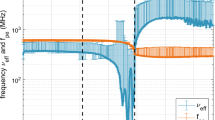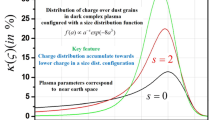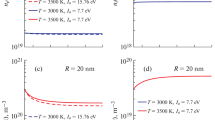Abstract
Particles in nonthermal dusty plasmas tend to charge negatively. However several effects can result in a significant fraction of the particles being neutral or positively charged, in which case they can deposit on surfaces that bound the plasma. Monte Carlo charging simulations were conducted to explore the effects of several parameters on the non-negative particle fraction of the stationary particle charge distribution. These simulations accounted for two effects not considered by the orbital motion limited theory of particle charging: single-particle charge limits, which were implemented by calculating electron tunneling currents from particles; and the increase in ion current to particles caused by charge-exchange collisions that occur within a particle’s capture radius. The effects of several parameters were considered, including particle size, in the range 1–10 nm; pressure, ranging from 0.1 to 10 Torr; electron temperature, from 1 to 5 eV; positive ion temperature, from 300 to 700 K; plasma electronegativity, characterized in terms of n +/n e ranging from 1 to 1000; and particle material, either SiO2 or Si. Within this parameter space, higher non-negative particle fractions are associated with smaller particle size, higher pressure, lower electron temperature, lower positive ion temperature, and higher electronegativity. Additionally, materials with lower electron affinities, such as SiO2, have higher non-negative particle fractions than materials with lower electron affinities, such as Si.









Similar content being viewed by others
References
Kortshagen UR, Sankaran RM, Pereira RN, Girshick SL, Wu JJ, Aydil ES (2016) Nonthermal plasma synthesis of nanocrystals: fundamental principles, materials, and applications. Chem Rev 116:11061–11127
Chaabane N, Suendo V, Vach H, Roca i Cabarrocas P (2006) Soft landing of silicon nanocrystals in plasma enhanced chemical vapor deposition. Appl Phys Lett 88:203111
Rosenberg M, Mendis DA (1996) Use of UV to reduce particle trapping in process plasmas. IEEE Trans Plasma Sci 24:1133–1136
Kortshagen U, Bhandarkar U (1999) Modeling of particulate coagulation in low pressure plasmas. Phys Rev E 60:887–898
Denysenko IB, Ostrikov K, Xu S, Yu MY, Diong CH (2003) Nanopowder management and control of plasma parameters in electronegative SiH4 plasmas. J Appl Phys 94:6097–6107
Agarwal P, Girshick SL (2014) Numerical modeling of the spatiotemporal behavior of an rf argon-silane plasma with dust particle nucleation and growth. Plasma Chem Plasma Process 34:489–503
Le Picard R, Markosyan AH, Porter DH, Girshick SL, Kushner MJ (2016) Synthesis of silicon nanoparticles in nonthermal capacitively-coupled flowing plasmas: processes and transport. Plasma Chem Plasma Process 36:941–972
Agarwal P, Girshick SL (2012) Sectional modeling of nanoparticle size and charge distributions in dusty plasmas. Plasma Sources Sci Technol 21:055023
Allen JE (1992) Probe theory—the orbital motion approach. Phys Scr 45:497–503
Matsoukas T, Russell M (1995) Particle charging in low-pressure plasmas. J Appl Phys 77:4285–4292
Matsoukas T, Russell M (1997) Fokker-Planck description of particle charging in ionized gases. Phys Rev E 55:991–994
Bilik N, Anthony R, Merritt BA, Aydil ES, Kortshagen UR (2015) Langmuir probe measurements of electron energy probability functions in dusty plasmas. J Phys D 48:105204
Le Picard R, Girshick SL (2016) The effect of single-particle charge limits on charge distributions in dusty plasmas. J Phys D 49:095201
Gallagher A (2000) A model of particle growth in silane discharges. Phys Rev E 62:2690–2706
Heijmans LCJ, Wetering FMJH, Nijdam S (2016) Comment on ‘The effect of single-particle charge limits on charge distributions in dusty plasmas’. J Phys D 49:388001
Le Picard R, Girshick SL (2016) Reply to ‘Comment on “The effect of single-particle charge limits on charge distributions in dusty plasmas”’. J Phys D 49:388002
Khrapak SA, Ratynskaia SV, Zobnin AV, Usachev AD, Yaroshenko VV, Thoma MH, Kretschmer M, Hofner H, Morfill GE, Petrov OF, Fortov VE (2005) Particle charge in the bulk of gas discharges. Phys Rev E 72:10
Gatti M, Kortshagen U (2008) Analytical model of particle charging in plasmas over a wide range of collisionality. Phys Rev E 78:046402–046406
Lieberman M, Lichtenberg A (2005) Principles of plasma discharges and materials processing, 2nd edn. Wiley, New York
Bouchoule A (ed) (1999) Dusty plasmas: physics, chemistry and technological impacts in plasma processing. Wiley, New York
Goree J (1992) Ion trapping by a charged dust grain in a plasma. Phys Rev Lett 69:277–280
Epstein PS (1924) Phys Rev 23:710
Roca i Cabarrocas P, Gay P, Hadjadj A (1996) Experimental evidence for nanoparticle deposition in continuous argon-silane plasmas: effects of silicon nanoparticles on film properties. J Vac Sci Technol A 14:655–659
Larriba-Andaluz C, Girshick SL (2017) Controlled fluxes of silicon nanoparticles to a substrate in pulsed radio-frequency argon–silane plasmas. Plasma Chem Plasma Process 37:43–58
Mangolini L, Kortshagen U (2009) Selective nanoparticle heating: another form of nonequilibrium in dusty plasmas. Phys Rev E 79:026405
Kramer NJ, Anthony RJ, Mamunuru M, Aydil ES, Kortshagen UR (2014) Plasma-induced crystallization of silicon nanoparticles. J Phys D 47:075202
Acknowledgements
This work was partially supported by the Lam Research Foundation, the U.S. National Science Foundation (CHE-124752), and the U.S. Dept. of Energy Office of Fusion Energy Science (DE-SC0001939).
Author information
Authors and Affiliations
Corresponding author
Rights and permissions
About this article
Cite this article
Mamunuru, M., Le Picard, R., Sakiyama, Y. et al. The Existence of Non-negatively Charged Dust Particles in Nonthermal Plasmas. Plasma Chem Plasma Process 37, 701–715 (2017). https://doi.org/10.1007/s11090-017-9798-6
Received:
Accepted:
Published:
Issue Date:
DOI: https://doi.org/10.1007/s11090-017-9798-6




